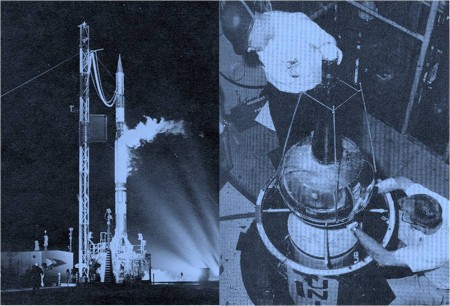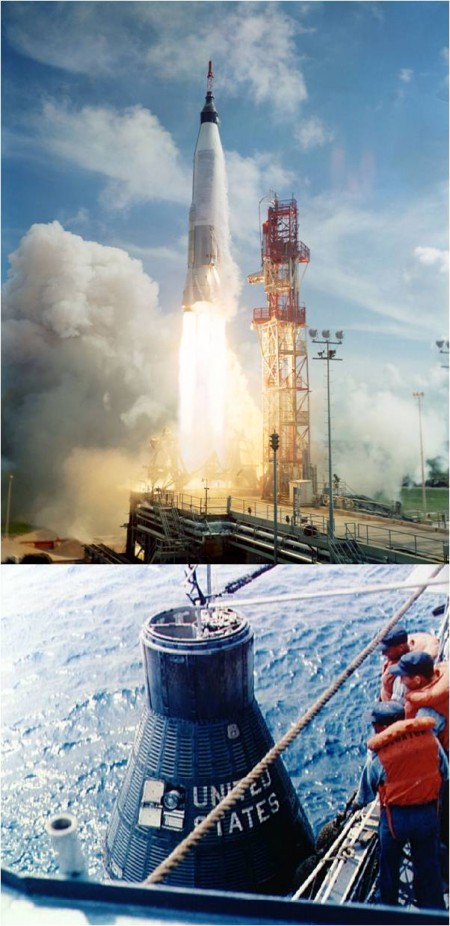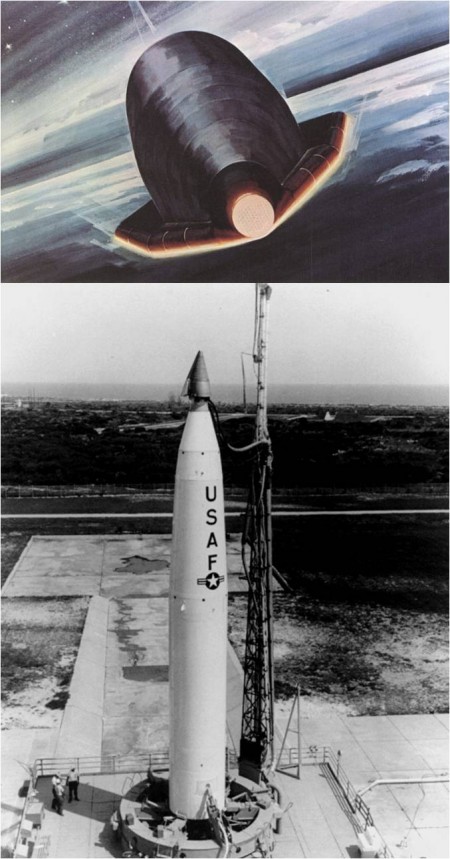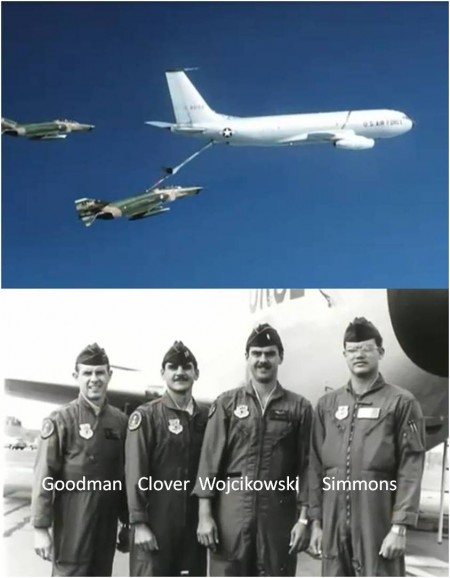
Fifty-three years ago this month, the Vanguard III scientific satellite was successfully launched into Earth orbit by a 3-stage Vanguard Satellite Launch Vehicle (SLV). The last of the pioneering Vanguard satellite series, Vanguard 3 made lasting contributions to the fields of earth science, space physics and satellite technology.
Project Vanguard was a United States satellite launching program that began in 1955. The primary goal was to orbit the nation’s first satellite during the International Geophysical Year (IGY) covering the period from 01 Jul 1957 to 31 December 1958. The Naval Research Laboratory (NRL) had overall technical responsibility for Project Vanguard.
Due to Cold War tensions, the Eisenhower Administration wanted to orbit a scientific satellite using a non-military launch vehicle. Thus, Project Vanguard was tasked with developing both a satellite and a companion launch vehicle. The latter, known as the Vanguard Satellite Launch Vehicle (SLV), was based on the Viking sounding rocket. The 3-stage Vanguard SLV was capable of orbiting an artificial satellite with a maximum weight of 50-lbs.
Vanguard I, weighing a mere 3 lbs, was successfully launched into orbit on Monday, 17 March 1958. While it was the first Vanguard satellite to achieve orbit, it was not the first American satellite. That distinction went to Explorer I, which was launched several weeks earlier on Friday, 31 January 1958. The primary mission of Vanguard I was quite basic in that its purpose was to determine the effects of the space environment on the primitive satellite and its systems.
Vanguard II successfully reached orbit on Tuesday, 17 February 1959. The 23-lb spherical satellite investigated cloud cover patterns in the Earth’s atmosphere during the daylight portion of each orbital pass. Vanguard II also helped to determine the mass density of the upper atmosphere as a function of altitude, latitude, season, and solar activity.
Vanguard III was launched from Cape Canaveral, Florida on Friday, 18 September 1959. Lift-off of the Vanguard SLV-7 from LC-18A occurred at 05:16:00 UTC. The 50-lb satellite was placed into a highly elliptical orbit measuring 1842-nm (apogee) by 276-nm (perigee). The third stage failed to separate from the satellite as planned. However, the effects of such on mission performance were minimal.
Over its 84-day mission period, Vanguard III mapped the magnetic field of the Earth at altitudes between apogee and perigee for latitudes between plus and minus 33 degrees. A micrometeroid detector recorded more than 6,500 impacts in orbit during a sample period of 66 days. Onboard sensors were also employed to measure the X-ray radiation emitted by the Sun and the effects that this radiation had on our atmosphere.
Like its predecessor, the Vanguard III satellite was used to determine the variation of upper atmosphere density with altitude, latitude, season and solar activity. Data were also obtained on the effects of atmospheric drag on orbital altitude decay. On Friday, 11 December 1959, transmission of data from Vanguard III ceased.
Vanguard III was the last Vanguard satellite to be orbited. From a programmatic standpoint, success did not come easy. Indeed, out of eleven (11) launches, only three (3) Vanguard satellites achieved orbit. However, the Vanguard Program’s pioneering contributions to satellite design, launch vehicle development, space tracking, spaceflight technology, earth sciences and space physics were significant.
As of this writing, the trio of Vanguard satellites launched back in the late 1950’s are still in orbit. While the first satellites (the Soviet Union’s Sputnik I and the United States Explorer I) fell out of orbit long ago, Vanguard III is expected to remain in orbit for another 250 years.

Fifty-one years ago this month, the first Project Mercury unmanned orbital space mission was successfully conducted. Known as Mercury-Atlas No. 4 (MA-4), this spaceflight paved the way for the United States’ first manned orbital mission which took place less than 6 months later.
Project Mercury was America’s first manned spaceflight program. Led by the National Aeronautics and Space Administration (NASA), the basic goals of Project Mercury were simple: (1) Orbit a manned spacecraft around the Earth, (2) investigate man’s ability to function in space and (3) recover both man and spacecraft safely.
The guidelines for achieving the above were equally straightforward: (1) Use existing technology and equipment wherever practical, (2) employ the most simple and reliable approach to system design, (3) place the spacecraft into orbit using an existing booster and (4) conduct a progressive and logical test program.
The Mercury spacecraft was developed and built by the McDonnell Aircraft Corporation. A pair of existing military missiles were manrated for use on Project Mercury. The Redstone Intermediate Range Ballistic Missile (IRBM) was the booster for suborbital flights while the Atlas intercontinental Ballistic Missile (ICBM) served as the launch vehicle for orbital missions.
In the 24 months between May 1961 and May 1963, a total of six (6) manned Mercury spaceflights were conducted with great success. Manned suborbital Mercury-Redstone (MR) missions were flown in May (MR-3) and July (MR-4) of 1961. These initial forays into space set the stage for the more demanding Mercury-Atlas (MA) orbital missions flown in February 1962 (MA-6), May 1962 (MA-7), October 1962 (MA-8) and May 1963 (MA-9).
The spectacular achievements of Mercury’s manned spaceflights was made possible by a supporting series of unmanned test shots. Indeed, between August of 1959 and November of 1961, a total of 20 unmanned tests flights were conducted in support of the manned program. These tests thoroughly investigated all aspects of spaceflight including launch, ascent, orbital ops, reentry, recovery and abort. Investigation of the latter was aided by the use of Little Joe (LJ) launch vehicles.
Mercury-Atlas No. 4 (MA-4) was the first successful orbital mission of the Mercury Program. The vehicle was launched from LC-14 at Cape Canaveral, Florida on Wednesday, 13 September 1961. Lift-off of the Atlas D one-and-a-half stage booster occurred at 14:04:16 UTC. The MA-4 payload consisted of an astronaut simulator, several voice tapes, a life support system, a trio of cameras, and instrumentation to measure flight noise, vibration and radiation levels.
MA-4 flew one orbit about the Earth prior to retrofire. Reentry was entirely nominal with drogue and main parachute deployment taking place at 41,750 ft and 10,500 ft, respectively. Splashdown occurred 153 nm east of Bermuda in the South Atlantic Ocean. Mission elapsed time was 109 minutes and 20 seconds. Within 90 minutes of landing, the little spacecraft was recovered by the crew of the USS Decatur.
Other than some minor system glitches, MA-4 achieved all of its mission objectives. Along with the subsequent MA-5 mission, in which a chimp named Enos completed a problem-plagued, but successful two-orbit flight, the United States stood at the threshold of manned orbital spaceflight at the end of November 1961. The historic and long-anticipated day came on Tuesday, 20 February 1962 when NASA Astronaut John Herschel Glenn, Jr. became the first American to orbit the Earth during MA-6.

Forty-nine years ago this month, the first ASSET flight test vehicle successfully flew 1,600 nm down the Eastern Test Range following launch from Cape Canaveral, Florida. Boosted atop a Thor launch vehicle, the hypersonic glider reached a maximum velocity of 10,900 mph (Mach 12).
The Aerothermodynamic/Elastic Structural Systems Environmental Tests (ASSET) Program was a United State Air Force flight research effort aimed at exploring hypersonic lifting entry. Programmatic objectives included evaluation of hypersonic lifting vehicle (1) reentry aerodynamic and aerothermodynamic phenomena (2) structural design concepts, and (3) panel flutter characteristics and body flap oscillatory pressures.
The basic ASSET vehicle configuration was a 70-deg delta planform wing with highly-radiused leading edges. The windward surface of this wing was flat and had a 10-deg break in slope roughly two-thirds of the way back from the nose. A blunted cone-cylinder combination was raked into the leeward surface of the wing to form the fuselage of the vehicle. The aft portion of the vehicle was terminated with a flat base region.
There were two (2) types of ASSET vehicles. The Aerothermoelastic Vehicle (AEV) variant was flown to investigate windward panel flutter characteristics and body flap oscillatory pressures. A pair of these vehicles were flown. Each weighed AEV weighed 1,225 lbs and was launched into a suborbital flight path by a Douglas Thor booster.
The Aerothermodynamic Structural Vehicle (ASV) variant was flown to determine external airframe surface temperature, heat flux and pressure distributions in hypersonic flight. These data were used to evaluate materials and structural concepts under reentry conditions. A quartet of these vehicles were flight tested. Each ASV weighed 1,130 lbs and was boosted by a Thor-Delta launch vehicle.
ASSET vehicles were boosted to altitudes between 168 KFT and 225 KFT depending on mission type. AEV entry insertion velocity was roughly 13,000 ft/sec while that for ASV shots varied between 16,000 and 19,500 ft/sec. ASSET performed hypersonic flight maneuvers via a combination of aerodynamic and propulsive controls. The windward-mounted body flap was the lone aerodynamic control surface while a set of 3-axis attitude control thrusters were located in the vehicle’s base region.
The first flight of the ASSET Program (ASV-1) took place on Wednesday, 18 September 1963. ASV-1 lift-off occurred at 09:39 UTC from Cape Canaveral’s LC-17B. Due to booster availability issues, a Thor DSV-2F launch vehicle was used for this mission rather than the higher energy Thor-Delta DSV-2G. Insertion altitude and velocity were 203,200 ft and 16,125 ft/sec, respectively. The ASV-1 mission was highly successful with the exception that the vehicle was lost when it sunk in the South Atlantic during recovery operations.
ASV-1 represented the first time in aerospace history that a lifting vehicle configuration had successfully flown a double-digit Mach number reentry trajectory. Five (5) more ASSET vehicles would fly before completion of the flight research program. The sixth and last mission occurred on Tuesday, 23 February 1965.
The ASSET Program garnered a wealth of first-ever hypersonic vehicle aerodynamic, aerothermodynamic, aerothermoelastic and flight controls data. This priceless information and the valuable experience gained during ASSET contributed significantly to the design and flight testing of the PRIME SV-5D and Space Shuttle Orbiter.
Strangely, only one of the ASSET flight test articles was ever recovered successfully. In particular, ASV-3 was recovered following its 1,800 nm suborbital flight down the Eastern Test Range on Wednesday, 22 July 1964. The recovered airframe is currently on display at the National Museum of the United States Air Force in Dayton, Ohio.

Twenty-nine years ago this week, the valiant crew of a USAF KC-135 Stratotanker performed multiple aerial refuelings of a stricken USAF F-4E Phantom II over the North Atlantic Ocean. Conducted under extremely perilous flight conditions, the remarkable actions of the aerial tanker’s crew allowed the F-4E to remain aloft long enough to safely divert to an alternate landing field.
On Monday, 05 September 1983, a pair of USAF F-4E Phantom II fighter-bombers departed the United States for a routine flight to Germany. To negotiate the trans-atlantic distance, the F-4E’s would require aerial refueling. As they approached the refueling rendezvous point, one of the aircraft developed trouble with its No. 2 engine. Though still operative, the engine experienced a significant loss of thrust.
The problem with the Phantom’s engine caused it to lose speed and altitude. Further, its No. 1 engine began to overheat as it tried to keep the aircraft airborne. As if this were not enough, the aircraft’s starboard hydraulic system became inoperative. Coupled with the fact that the fuel gauge was edging toward empty, the specter of an ejection and parachute landing in the cold Atlantic looked all but certain for the F-4E crew.
Enter the venerable KC-135 Stratotanker and her crew of Captain Robert J. Goodman, Captain Michael R. Clover, 1st Lt Karol R. Wojcikowski and SSgt Douglas D. Simmons. Based with the 42nd Aerial Refueling Squadron, their immediate problem was two-fold. First, locate and navigate to the pair of F-4E aircraft flying somewhere over the open ocean. Second, get enough fuel to both aircraft so the latter could complete their trans-atlantic hop. Time was of the essence.
Following execution of the rendezvous, the KC-135 crew needed to get their steed out in front of the fuel-hungry Phantoms. The properly operating Phantom quickly took on a load of fuel. However, the stricken aircraft continued to lose altitude as its pilot struggled just to keep the aircraft in the air. By the time the first hook-up occurred, both the F-4E and KC-135 were flying below an altitude of 7,000 feet.
Whereas normal refueling airspeed is 315 knots, the refueling operation between the KC-135 and F-4E occurred below 200 knots. Both aircraft had to fly at high angle-of-attack to generate sufficient lift at this low airspeed. Boom Operator Simmons was faced with a particularly difficult challenge in that the failed starboard hydraulics of the F-4E caused it to yaw to the right. Nonetheless, he was able to make the hook-up with the F-4E refueling recepticle and transfer a bit of fuel to the ailing aircraft.
The transfer of fuel ceased during the first aerial refueling when the mechanical limits of the aircraft-to-aircraft connection were exceeded. The F-4E started to dive as it came off the refueling boom. At this critical juncture, Captain Goodman made the decision to follow the Phantom and get down in front of it for another go at aerial refueling. As the second fuel transfer operation began, the airspeed indicator registered 190 knots; barely above the KC-135’s landing speed.
While additional fuel was transferred to the F-4E, it was still not enough for it to make the divert airfield at Gander, New Foundland. The KC-135 performed two more risky aerial refuelings of the struggling Phantom. The last of which occurred at an altitude of only 1,600 feet above the ocean. At times during these harrowing operations, the KC-135 actually towed the F-4E on its refueling boom to help the latter gain altitude.
At length, the F-4E manged to climb to 6,000 feet and maintain 220 knots as its No. 1 engine began to cool. Able to fend for itself once again, the Phantom punched-off the KC-135 refueling boom. Goodman and crew continued to escort the F-4E to the now-close landing field at Gander, New Foundland. The Phantom pilot greased the landing much to the relief and joy of all.
For their heroic efforts on that eventful September day over the North Atlantic, the crew of the KC-135 received the USAF’s Mackay Trophy for the most meritorious flight of 1983.





